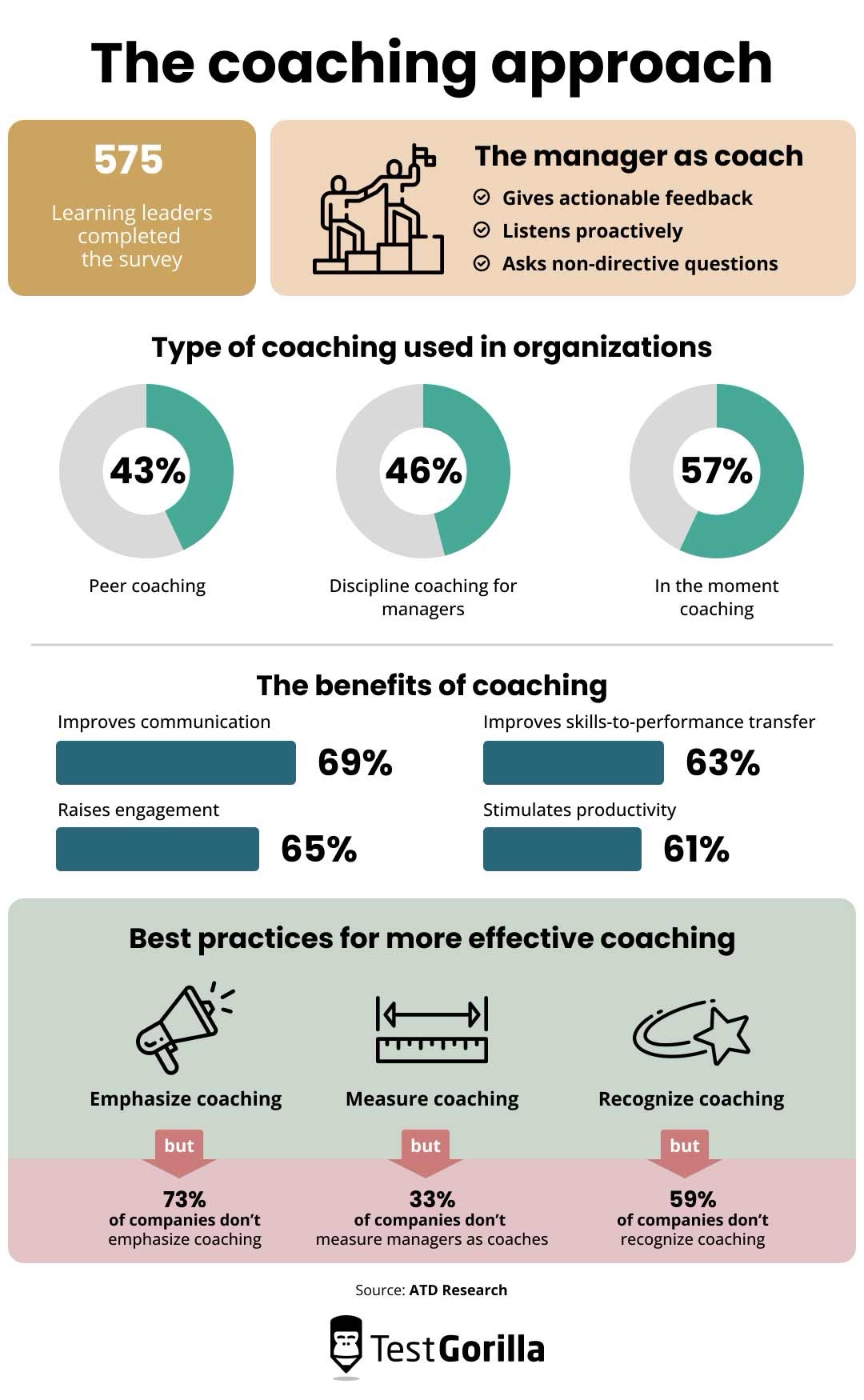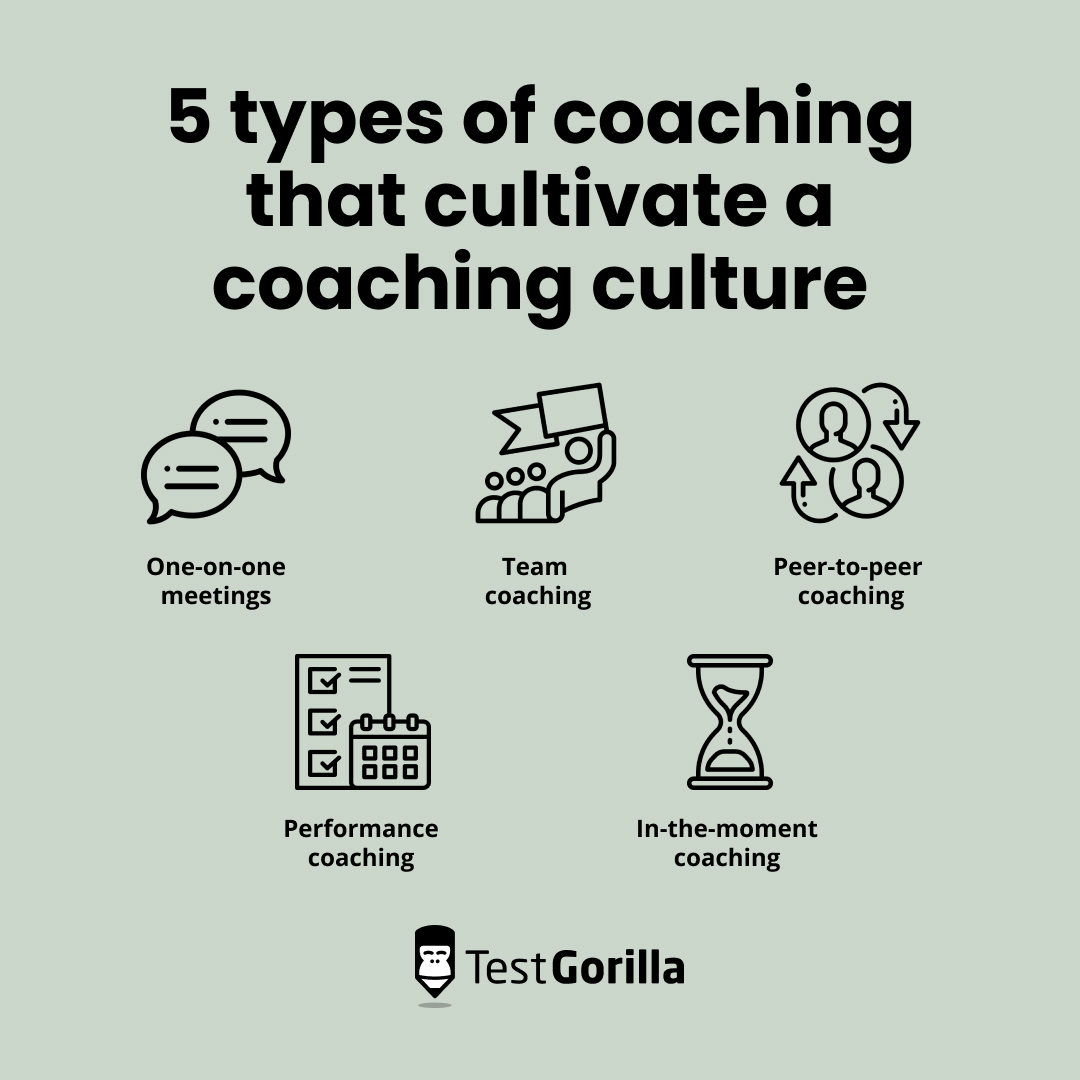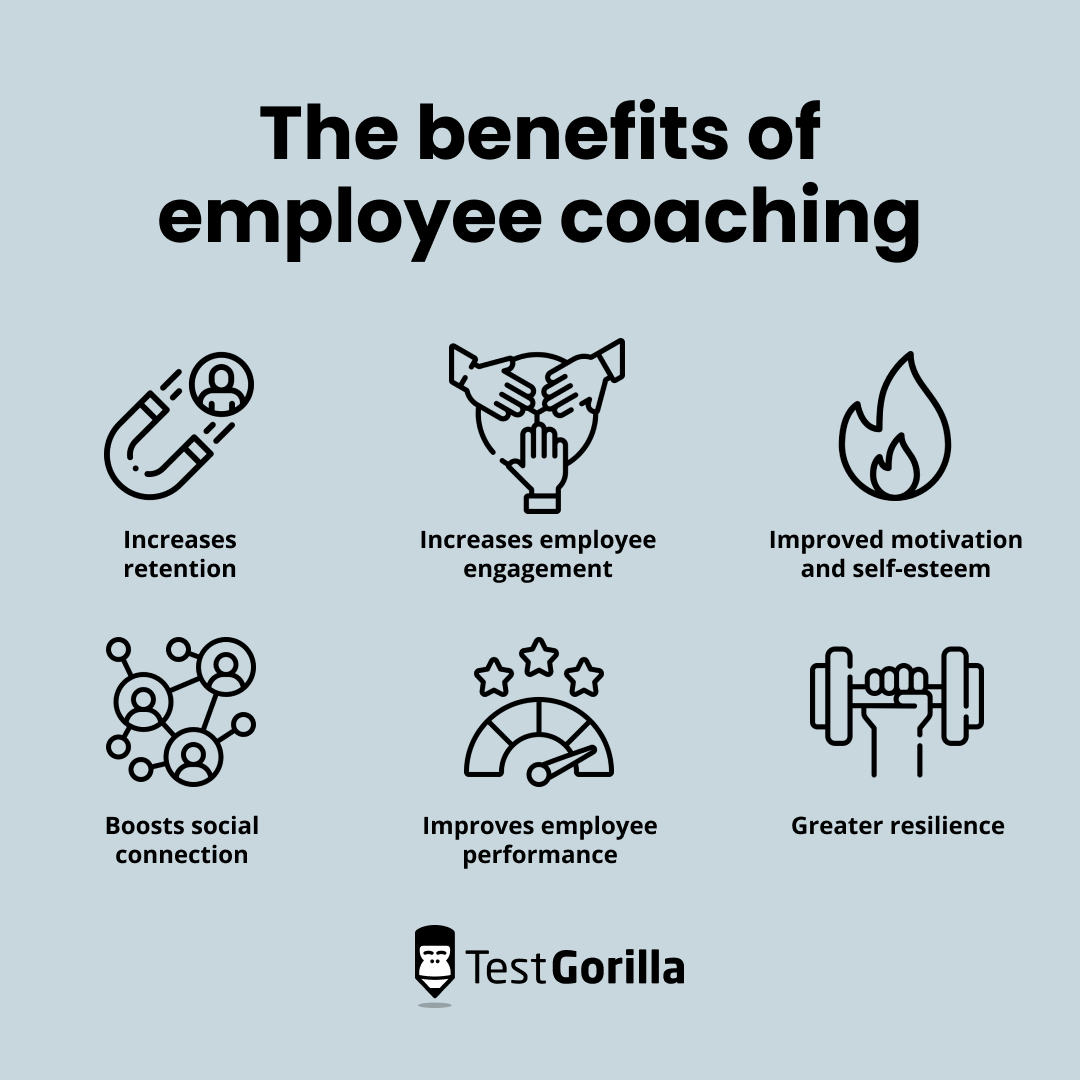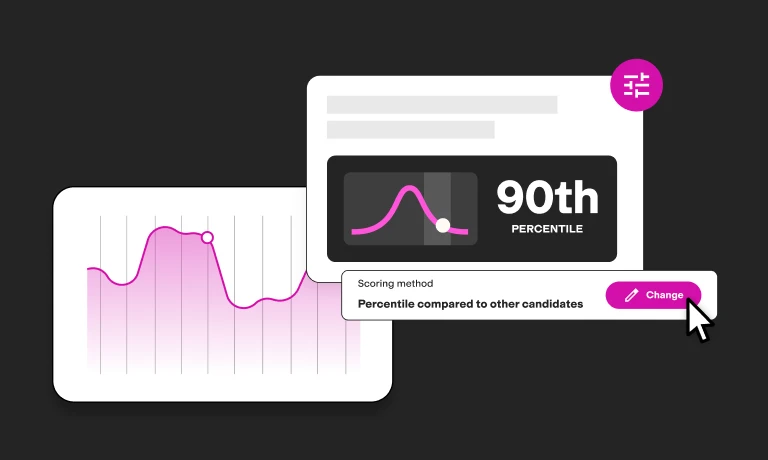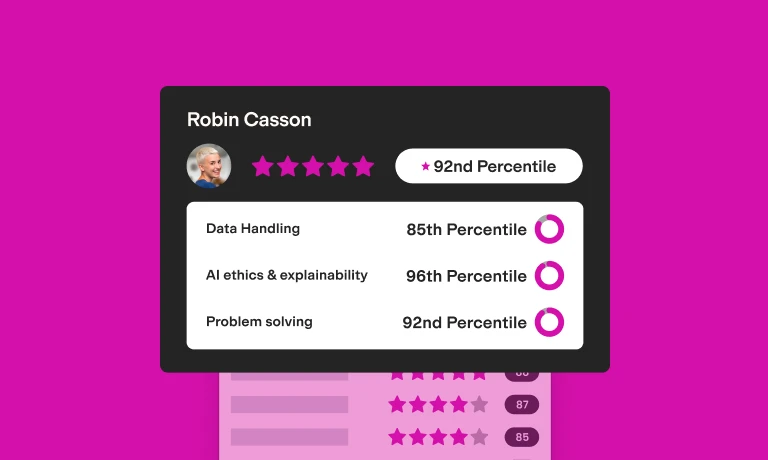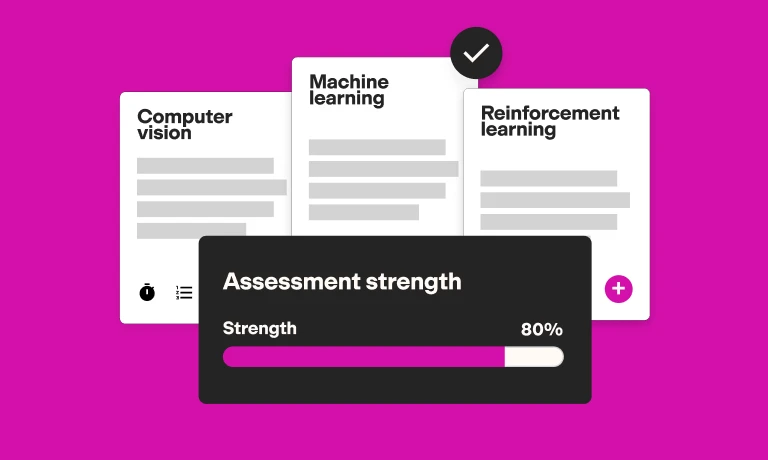Employee coaching: Leverage this talent retention strategy and support development
Employees are always looking for the opportunity to expand their careers, with 86% of employees saying they’d switch jobs for one with more chances to grow.[1]
This number reflects the cost of not investing in employees' needs, which is backed up by research that shows companies that invest in employee development see a 58% increase in employee retention rates.[2]
If your employees feel that they are not valued or able to grow, you risk losing them.
One way you can help them develop is through regular employee coaching.
Coaching and mentoring staff is a crucial talent retention strategy that helps you to:
Improve employee engagement
Retain talented workers for longer (and upskill them)
Improve your bottom line thanks to motivated, high-performing employees
In this guide, we cover the benefits of employee coaching, how to use this strategy to your advantage, and how to effectively coach an employee (with best practices).
Table of contents
- What is employee coaching?
- Why is coaching employees important?
- The benefits of employee coaching
- 8 best practices for leveraging employee coaching to retain and grow your best performers
- 3 examples of companies succeeding with employee coaching as a talent retention strategy
- Keep top talent around with an effective employee coaching plan
What is employee coaching?
Employee coaching is the process of coaches working closely with a team member to help them perform better at work so that they can better fulfill their personal and professional goals.
The coach is usually a senior teammate, manager, or any more experienced employee. The coach meets with their coachees regularly (either in person or virtually for remote employees) to provide them with helpful feedback or advice.
An employee coaching strategy engages other employee retention trends, such as upward feedback, to foster an environment of continuous development in your organizational culture.
The focal point of coaching is both remedying inadequacies and cultivating existing qualities.
Good coaches are a lot like good mentors and share many of the same qualities. Coaches and mentors both support employee self-development by attentively listening, understanding, supporting development plans, and giving personalized advice.
A solid coaching program builds communication and engagement in the workplace, as seen in this summary from the Association for Talent Development:
Employee coaching is a two-way street where both parties give and receive. The employer gets a team member with more skills, knowledge, and professional motivation, and the employee feels heard, valued, and more confident in themselves and the company.
Coaches therefore focus heavily on upping their students' skills – they also help them cultivate a greater sense of fulfillment, self-assurance, and joy in their careers.
The 5 types of employee coaching
Coaching employees in the workplace isn’t one-dimensional, and it’s important to consider the multiple types available.
Here are the five most common types of employee coaching:
One-on-one meetings: This is a two-person meeting between two individuals working for the same company, typically involving an employee and their coach
Team coaching: This coaching style between a coach and two or more employees centers around coaching teams to reach their ambitions while crafting or sustaining an all-embracing atmosphere
Peer-to-peer coaching: Peer coaching is when two or more colleagues collaborate, exchange insights, hone their skills, and resolve issues together
Performance coaching: Coaching employees to improve performance is a method of aiding people or groups to recognize their talents and determine areas that need improvement to accomplish their objectives
In-the-moment coaching: In-the-moment coaching conversations involve the coach helping the employee with one or more challenges as they occur, providing a direct, hands-on approach, and building problem-solving skills
Why is coaching employees important?
Employee coaching is one of the best ways to provide your employees with growth opportunities.
It’s common for modern job seekers to look for companies that have growth opportunities. Therefore, a strong employee coaching strategy helps attract new hires, and the new talent is likely to stick around for longer because they have a work environment where they can reach their career goals.
A long-term pay-off associated with helping employees grow is that it reduces new hiring costs and increases internal mobility (more on this in the benefits section). For example, you can have senior employees coach the person who'll eventually take on their role after their retirement.
Continuous improvement advocates that teams and businesses should always strive to deliver higher-quality results. A mindset of incremental improvement can be nurtured with employee coaching, making employees more resilient and improving their overall engagement levels.
The best insights on HR and recruitment, delivered to your inbox.
Biweekly updates. No spam. Unsubscribe any time.
The benefits of employee coaching
The benefits of employee coaching extend further than just the employee being coached.
A well-structured employee coaching program builds a culture of communication and growth in the workplace, contributing to organizational success on a large scale.
Let’s take a closer look at how these benefits play out in the coaching structure.
1. Increases retention
Employees who gain value through coaching are more likely to stick around. Research from Deloitte showed that two-thirds of millennials who intended to stay with their organization for more than five years had a mentor.[3]
The negative effects of a bad employee turnover rate ripple through more areas than just your bottom line. It can cause work output gaps, leading to either lower quality deliverables (from overworked employees making up for the gap) or delays.
Role-specific knowledge and employee experience are also lost when good employees leave. There’s no quantifiable way to measure these, but they can be felt in things from day-to-day processes to long-term initiatives.
One of the top strategies to keep great employees around is through effective coaching practices. Coaching makes employees feel cared for on an individual level and engages them positively, giving them a reason to stick around.
Not only that, but a culture of coaching can also improve your talent acquisition strategy by improving your corporate reputation. Job candidates who see that your company has a culture focusing on development are more likely to apply with you.
2. Increases employee engagement
Employee engagement refers to the connection employees have with their work, their team, and their organization.
Employees who are isolated or don’t feel any development tend to feel more disengaged, and disengaged employees are never good news. A company loses, on average, $2,246 per disengaged employee every year.[4]
Some other consequences of disengagement include lower quality work, high turnover rates, and negative views about the company.
A good manager or coach acts as a servant leader to build personal connections with their employees.
Servant leaders know how to engage their new employees and keep them engaged using positive techniques. They do so by praising them, motivating them to reach for goals, and helping them to get there shoulder to shoulder.
Servant leaders are also great at coaching employees with negative attitudes, helping to avert what could have otherwise been a bad hire.
3. Improved motivation and self-esteem
When employees are coached correctly, they naturally feel better about themselves and their work, as well as more motivated to contribute.
Traditionally, inspiring one's employees to perform better has been accomplished by offering external rewards, such as employee compensation and employee benefits.
In today's knowledge-based economy, motivating employees requires a method beyond the traditional carrot-and-stick approach.
A servant leader or coach encourages employees to take on new roles or to grow from within their current ones. Combined with additional support like a professional development plan, this gives a significant boost to the employee’s motivation.
4. Boosts social connection and working relationships
Coaching sessions (either one-on-one or in groups) can help to build strong social connections and work relationships.
As humans, we're biologically wired with a need to connect with others. And when you consider just how much time we spend at work, it’s one of the primary places we get to satisfy that basic, intrinsic need.
Neuroscience research has shown that when individuals experience a sense of compassion and unity, they tend to do better and be more successful in achieving a shared objective.[5]
Employers who actively support the development of employee wellbeing in the workplace through initiatives, such as employee coaching, benefit from increased levels of trust, more open communication, and a greater sense of team spirit.
5. Improves employee performance
All the benefits mentioned above lead to one massive gain for businesses, which is higher employee performance.
For example, Gallup's research shows that a 21% surge in sales could be expected if employee engagement was increased.[6]
Coaching employees to improve job performance can also be done with one-on-one or in-the-moment sessions since they create a safe place to give constructive feedback.
6. Greater resilience
Coaching employees helps them to feel in control of their work because they are receiving managerial support.
Without this type of support, it's difficult for them to feel secure in their role.
BetterUp's research has revealed that workplace coaching leads to a 92% increase in employees' sense of control, meaning improved resilience in the workplace.[7]
In times of rapid transformation and tumult, having a sense of control over one's surroundings is of the utmost importance. It can provide individuals with the stability and fortitude they need to stay resilient.
8 best practices for leveraging employee coaching to retain and grow your best performers
With a clear grasp of the many benefits of coaching, let’s now explore eight best practices you can apply to retain and grow your top talent in-house.
How to leverage employee coaching: 8 proven practices
Best practice | Quick summary |
1. Use personality and behavioral assessments to facilitate development | Assessments help you identify an employee’s developmental strengths and weaknesses |
2. Help employees build professional development plans (PDP) | A PDP is an action plan to build employees up and guide them toward their professional goals |
3. Encourage feedback both ways | Two-way feedback lets employees feel more comfortable asking coaches for help, and gives valuable insights to coaches |
4. Track and validate your employees' skills with talent assessments | Using talent assessments give you a window into what to coach employees on |
5. Actively seek out opportunities for growth | Taking opportunities to push your employees to grow is one of the best ways to engage them as a coach |
6. Communicate, but don't micromanage | Coaches should act as soundboards to allow their employees to find solutions independently |
7. Help your employees make meaningful connections (and create a good work culture) | When you help employees feel more connected in their workplace, it motivates them (and those around them) to work towards a common goal |
8. Use a template to create and manage your employee coaching strategy | Use a standardized form to objectively evaluate your employee’s performance and analyze areas for further advancement |
1. Use personality and behavioral assessments to facilitate development
Talent assessment tests help you to better understand the work habits, styles, and motivations of your employees.
This knowledge helps you develop a more successful coaching strategy tailored to individual employees. You can learn more about their current qualities and how to lean on the strengths that they currently have.
When you lean on their current strengths, you can naturally motivate them and boost their self-esteem.
For example, say Sarah (a content writer) takes these tests, and you see that she has some strong leadership and project management skills. You can then focus on developing these skills further by giving her more managerial work, i.e., asking her to support the content strategist during capacity planning and deadline management.
With a clear idea of an employee's behavior, you can plan how to use them in your current and future business ventures. It can even help you create an internal talent marketplace register.
These tests further enable you to gauge an employee’s personality traits and match them up with coaches who best complement them. Doing this helps you avoid matching them with coaches who might not fit their personality, which can sometimes do more harm than good.
Say you tested John and saw that he was an introvert, so you matched him with an introverted coach, which reduced his stress levels. If you matched him with an extroverted coach, it might have the opposite effect on him.
2. Help employees build professional development plans (PDP)
A professional development plan outlines an employee's career growth objectives, helping them set goals and the steps necessary to reach them.
A PDP enables you to develop a targeted, meaningful coaching program for an employee. This way, you can help them meet the development goals that are most relevant to them, as opposed to coaching them in things that they may not even be that interested in.
For Sarah (who wants to take a manager role), you can create a PDP roadmap focusing more on developing her managerial skills than learning new writing skills.
A PDP also helps managers identify staff who wish to fill roles that fit their long-term strategy.
For example, say you have a plan for a new website and CRM system, and you forecast that you’ll need a new team manager to lead this project in one year’s time. The PDP to develop Sarah's managerial skills can align directly with the forecasted growth, and if appropriately coached, she can glide into the new role.
3. Encourage feedback both ways
Coaching is obviously about giving employee feedback, but it's equally important to ask for feedback in return – also called “upward feedback.”
With upward feedback, you can make your coaching more effective since you know what works and what doesn’t. It’s also a way for the coaches to grow themselves.
For example, let's say you ask Sarah for feedback about how you have been coaching her. Sarah tells you that she feels the management techniques you recommended to her worked well but that her team might benefit from a work management system. So you decide to invest in a work management app that helps Sarah’s team and the whole company.
In another scenario, Max (an SEO writer) might tell you he needs more challenges. Together, you can plan for his next move up in the company, which might be something like a senior SEO position. He might tell you that he isn’t benefiting from the team coaching sessions and that he would do better with you one-on-one.
4. Track and validate your employees' skills with talent assessments
Tracking and validating your employee progress helps you see if your coaching has been effective.
You can verify the effectiveness of your employee coaching with regular talent assessments.
This way, if there are any knowledge or skill gaps after their training, you can fill them. You can also avoid giving employees new duties or roles they aren't ready for yet.
If you’re trying to help an employee develop toward a content manager role, something like the Content Strategy test can give you your initial baseline. Then, after three months, you test them again and compare the scores to see how effective your employee training programs are and adjust your coaching as necessary.
Skills tests also help you identify skills that certain employees are learning faster than others. As coaches, you can easily see who might be ready for the next level and who to keep mentoring at their current level.
5. Actively seek out opportunities for growth
When you (as the manager) see an opportunity for coaching and development, take it. Offer opportunities to employees who show promise in specific fields. Employees who are given continuous growth opportunities tend to be more engaged and satisfied.
Maybe Max scored higher than other candidates on a Technical SEO test, leading you to suggest he pursue a specialist SEO career path. You can then build a PDP to help Max grow his skills and use regular skills assessments (every couple of months) to validate his growth.
Growth can be horizontal (within the same role) or vertical (new career options). Coaches can help employees see the wealth of opportunities that employees might otherwise miss.
6. Communicate, but don't micromanage
It's important to be there for your workers as a coach, but don't micromanage – let them grow naturally.
The coach isn’t there to ‘solve’ problems but rather to be a sounding board and help the coachee understand how to solve the problem and/or progress in life, business, and work.
To do this, it helps if the coaches observe and then ask good questions.
Asking good questions means helping the other person reflect on a problem in a way that can help them figure it out independently.
For example, Sarah approaches you about a concern with a new client's content strategy. She mentions having trouble aligning the new content plans to the new client's vague goals.
Instead of telling Sarah how to solve this, you can ask her a good question like “How do you see their brand image and ideal customer?” which you can follow up with, “Would a few sample strategies help?”
Sarah can then reflect on these questions, which helps her decide to create a few samples that she can use to demo the new strategy with the client before committing to a full-on plan of attack.
Finally, if you catch your employees doing something good, compliment them – unfortunately, employee recognition is a rare commodity in many corporate cultures. Remember to praise in public and condemn in private, but avoid criticizing as much as possible, even if you're coaching an employee with a bad attitude.
7. Help your employees make meaningful connections (and create a good work culture)
Coaches should help their employees to make powerful connections so they can draw guidance and motivation for more sources of inspiration.
A report by Hays reveals that 47% of employees leave their jobs because of the lack of a good company culture.[8]
An inclusive culture helps keep your employees around and also improves employee engagement and productivity.
You can also introduce your employees to valuable coaches or mentors in person or on LinkedIn. Leadership communication skills are an excellent way to help them feel more secure.
Lastly, you can set up opportunities for them to work with their team. For example, you can introduce Max to other senior technical SEO specialists within the company and have him work under them.
8. Use a template to create and manage your employee coaching strategy
An employee coaching template is a comprehensive document used to arrange and present coaching sessions within a company. It sets out the objectives of the coaching program, how they will be achieved, and the ways of assessing the progress and success of the participants.
Upon completion of the coaching program, you can take advantage of the form to evaluate your employee’s performance, analyze areas for advancement, and add further comments.
Although it may be tempting to try and capture everything you want to accomplish, it’s better to keep it short and focused on the key takeaway. Otherwise, it can take too much time and distract you from your primary focus.
Here’s a template you can use and easily tailor to your needs. For this one, we have filled it in with a basic example where we’re running a managerial coaching program:
Program Title: TestGorilla’s Managerial Coaching Program for Up-and-Comers
Date: February 29, 2024
Overview:
This coaching program, designed for entry-level employees, is intended to increase their management capabilities which are necessary for successful leadership in future roles. Participants will learn about active listening, communication for leadership, and how to resolve conflicts.
These skills empower managers to engage their teams and promote a positive work culture within our organization.
Department: Marketing
Employee: Sarah H. [Entry-level marketing assistant]
Coach: Jacob O. [Marketing Team Lead]
3 examples of companies succeeding with employee coaching as a talent retention strategy
Next, let’s explore a few highly successful retention strategies by making use of three employee coaching case studies.
Experts in employee coaching
Company | Employee coaching examples |
1. Dolby | Provides a mix of in-person and online instruction, self-study materials, and one-on-one mentoring |
2. Heineken | Uses a reverse mentoring program where senior management learns from up-and-comers, staying on top of emerging trends and technologies |
3. Salesforce | Utilizes external coaches to help its employees personally and professionally |
Dolby
Dolby, the audio, visual, and voice technology giant, believes that helping its employees learn new skills through capability building and career development is key to the company’s future success.
At Dolby, training and growth opportunities include in-person and online instruction, self-guided study materials, and individual mentoring.
Here are a few vital ways it implemented employee coaching techniques:
Dolby coaches are trained and instructed to have high-quality, motivational conversations with employees
Coaches empower employees to solve problems by letting employees take the first pass at new issues
The company also invests in tools (like skill assessments) to help supervisors develop their teams and build a more effective workforce
Heineken
Heineken, the world-famous brewery, takes a unique approach to its employee coaching process.
The company’s senior executives decided to implement a reverse mentoring program, where junior employees mentor senior leaders and executives.
This reverse coaching and mentoring program is especially helpful for promoting natural knowledge sharing about emerging trends and technologies. Younger employees are often early adopters of new tools and are ideal candidates for coaching and mentoring more senior employees who might not be familiar with the latest generation of technology.
Salesforce
Salesforce, the cloud-based CRM software company, provides its employees with development coaching through its partnership with BetterUp.
Its BetterUp coaches are trained career therapists who help Salesforce employees on multiple levels – professionally and personally.
BetterUp coaches also:
Teach them how to manage stress with science-backed tools and workshops
Provide guidance on meals and how to sleep properly
Build resilience and help employees maintain a positive mindset
Aside from its partnership with BetterUp, Salesforce also commits to actively listening to employees and building meaningful in-house systems that aid employee growth and wellbeing.
Keep top talent around with an effective employee coaching plan
Top talent seeks out and remains with companies that support their professional development and provide more than just an attractive salary.
With strong employee coaching strategies, you can expect to:
Engage your employees and boost productivity
Boost retention rates
Increase internal mobility
Build a positive, inclusive corporate culture
We recommend you combine employee coaching with skills-based hiring. You can then use a Motivation test to seek out driven candidates who are more likely to identify with and flourish in a developmental culture that revolves around employee coaching.
Next, learn more about how you can attract and retain top talent through the creation of a robust learning and development strategy.
Sources
“The Employee Experience will be Critical to Business Success in 2019”. (January 7, 2019). Cision. Retrieved November 18, 2023. https://www.prnewswire.com/news-releases/the-employee-experience-will-be-critical-to-business-success-in-2019-according-to-new-hiring-outlook-report-by-the-execusearch-group-300773946.html
Harper, Jane. (January 9, 2023). “2023 HR Trends: A Look Ahead”. The HR Digest. Retrieved November 18, 2023. https://www.thehrdigest.com/2023-hr-trends-a-look-ahead/
“The 2016 Deloitte Millennial Survey”. (2016). Deloitte. Retrieved November 18, 2023. https://www2.deloitte.com/content/dam/Deloitte/global/Documents/About-Deloitte/gx-millenial-survey-2016-exec-summary.pdf
Petrone, Paul. (March 24, 2017) “How to calculate the cost of employee disengagement”. LinkedIn Learning. Retrieved November 18, 2023. https://www.linkedin.com/business/learning/blog/learner-engagement/how-to-calculate-the-cost-of-employee-disengagement
Zak, Paul; Barraza, Jorge. (November 2013) “The neurobiology of collective action”. NCBI. Retrieved November 18, 2023. https://www.ncbi.nlm.nih.gov/pmc/articles/PMC3832785/
“The Benefits of Employee Engagement”. (January 7, 2023). Gallup. Retrieved November 18, 2023. https://www.gallup.com/workplace/236927/employee-engagement-drives-growth.aspx
Miles, Madeline. (October 5, 2022). “9 coaching skills every leader needs”. BetterUp. Retrieved November 18, 2023. https://www.betterup.com/blog/coaching-skills
“What People Want”. (2017). Hays. Retrieved 18 November 2023. https://www.hays.com/documents/d/hays-usa/what-people-want-us_2017_digital
You've scrolled this far
Why not try TestGorilla for free, and see what happens when you put skills first.


